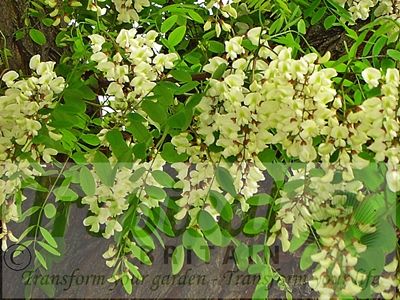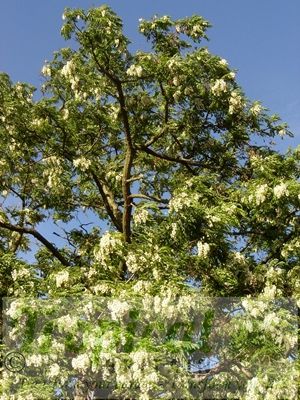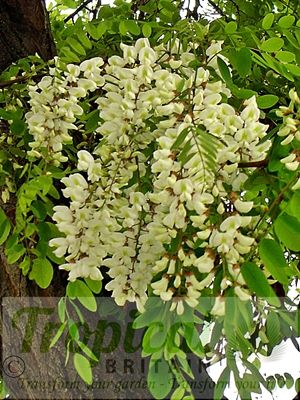Robinia pseudoacacia, the Black Locust, is a native of the Central and Southern Appalachians in the Eastern States of the USA where it naturally occurs as far north as Pennsylvania, then down through the Virginias, Ohio, North Carolina, Kentucky, Tennessee, Georgia, Alabama and - in other populations - further west to Missouri, Arkansas and Oklahoma.
The Black Locust was one of the first American trees introduced to Europe. Who exactly introduced it - and when - is a matter of some debate but what can be said with some certainty is that it was grown in France by Jean Robin, (b.1550-d.1629), arborist and gardener for Henri III, Henri IV and Louis XIII, who, together with his son Vespasian Robin, (b.1579-d.1662) assembled a fine collection of rare plants that eventually was incorporated into the Jardin des Plantes.
It was also grown in Britain by John Tradescant the Younger, (b.1608 – d.1662) and quite probably by his father, John Tradescant the Elder (b. circa 1570s – d.1638).
The pre-Linnaean names for it were Locusta Virginiana Arbor, Acacia Americana Robini and Acacia Virginensis spinosa.
In 1753 Linnaeus honoured the two French horticulturalists by renaming the genus Robinia.
Robinia pseudoacacia was also grown by one of the great pioneers of British exotic gardening, Archibald Campbell, who became Earl and Viscount Islay in 1706 and Duke of Argyll in 1743. In 1722, he acquired 40 acres in Whitton, to the west of Twickenham and the property eventually grew to some 55 acres. He created there - with considerable enthusiasm and skill - a vast formal garden, arboretum and nursery.
Alexander Pope, who lived on the other side of Twickenham, wrote of the property:
'In this small spit whole paradise you'll see
With all its plants but the Forbidden Tree...'
...and, in her "Short Account of the Principle Seats and Gardens in and about Twickenham", (1760) Joel-Henrietta Pye writes: 'In one part of the garden there is a fine collection of exotics; among which are, the coffee tree, the banana, the chian pepper, the palm tree, the pistachio tree and the torch thistle, and many others, equally valuable for their scarcity and beauty: among the rest the evergreen Oak, which flourishes in equal verdure all the year, and has a leaf exactly like a myrtle; also a Cork Tree.'
Lord Islay had built a large greenhouse on the property and it is tempting to speculate about exactly what palm tree he was growing there, some 70 or more years before the introduction of Trachycarpus fortunei to the United Kingdom.
After, the Duke of Argyll's death in 1761, his nephew, the Earl of Bute, who was botanical advisor to Princess Augusta, arranged, in 1762, for some of his uncle's trees to be transplanted to her nearby gardens in what we know today as The Royal Botanic Gardens, Kew. The five trees planted at that time became known as "The Old Lions" and one of these plants was a specimen of Robinia pseudoacacia which can be seen today growing in the lawn to the front of the Orangery where a 5 acre arboretum was laid out by William Aiton. It is one of the oldest plants in Kew Gardens.
Sadly, little of the Duke of Argyll's extraordinary experiment in exotic gardening at Whitton Park remains today and much of the estate has been built over.
Robinia pseudoacacia is a wonderful tree, with its bright-green compound foliage and gorgeous creamy-white flowers that have an intense scent reminiscent of vanilla or orange-blossom. These nectar-producing flowers are highly attractive to bees and appear in May or June, hanging down in elegant pendulous racemes. A legume, Robinia is capable of growing in poor soils, fixing nitrogen from the soil around its root nodules.
A very fast growing tree, it should only be planted if there is a great deal of room for it to grow as not only will it grow tall, its ability to send up suckers a long distance from the trunk is well known. However, if you are designing a large landscape area and have the space, it is a very handsome choice and quickly establishes itself into a good size.
The very fine and hard-grained wood of Robinia has been rendered commercially unusable in North America by infestations of borer beetle and in Europe its potential as a replacement for tropical hard woods is only now beginning to be recognised.
Additional Information
| Order | Fabales |
|---|---|
| Family | Fabaceae |
| Sub-Family | Faboideae |
| Geographical Origin | USA, South Eastern States, Appalachians |
| Cultivation | Full sun. Shelter from strong winds |
| Eventual Height | 20-30 m. Older specimens can grow taller |
| Eventual Spread | 10 m. Plant away from buildings and drains |
| Hardiness | Fully hardy. Deciduous |

Free DELIVERY
ON ALL ORDERS OVER £99THIS OFFER IS VALID ON ALL OUR STORE ITEMS.












